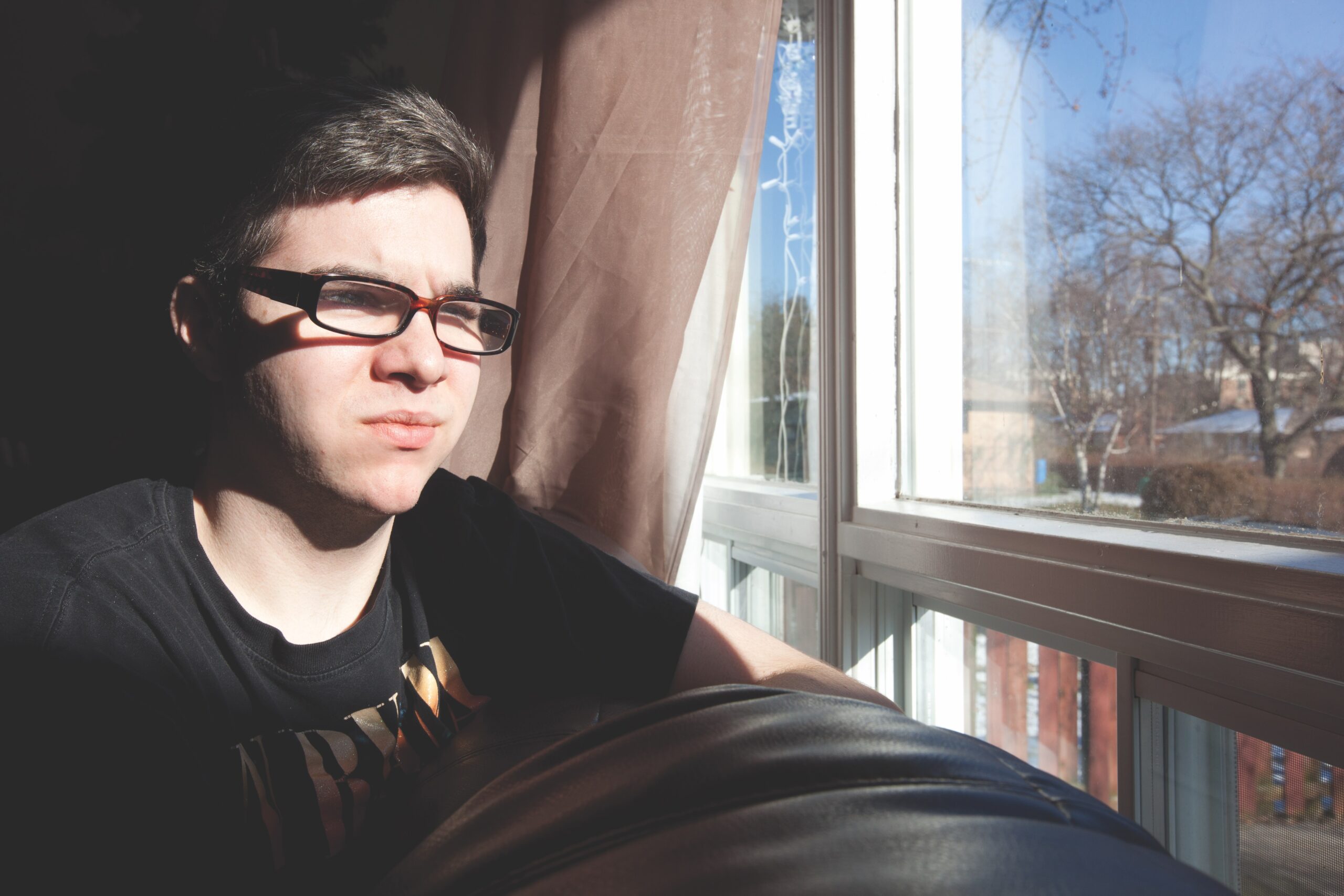When the autumn morning sky brightens over Burlington, Ont., the sight of the lakeshore dominates the leafy landscape. In nearby cul-de-sacs, post-war bungalows and row houses with curtained windows and manicured lawns intermingle. Inconspicuous among them is an older-style residence painted pale beige with waist-high fencing all around. At the front, a shiny black plaque boasts of recent Rotary Club renovations, while a rubber doormat simply welcomes “Dear Friends.”
Inside, there is little in the way of decoration, but small touches express the lingering idea of home: knick-knacks and candy dishes have been placed on tables; knit blankets have been draped over a sofa and set of recliners.
As you enter one of the house’s four bedrooms, it’s possible to surmise the tastes and interests of its occupant. A fresh coat of electric blue paint brightens the walls, which are also covered with posters, including one from the TV sitcom The Big Bang Theory. Neatly piled by the bedside are a faux-suede Stetson, a plastic samurai sword and copies of Japanese manga fiction — graphic novels that are reassuringly linear to Chris Stafford.
“Honestly, when it comes to manga, I just love it,” says the 21-year-old as his mother, Andrea — who is visiting Chris for the day — intently watches from the corner of the bedroom.
Chris Stafford has a high-functioning form of autism. Since last fall, he has been living at Stratton House, a community-based home for people with developmental disabilities, along with three others and their aides.
If societies are measured by the way they treat their most vulnerable members, then it’s worth examining how we regard people with developmental disabilities. In Canada, more than 680,000 children, youth and adults are living with autism, cerebral palsy or Down syndrome, according to the Canadian Association for Community Living (CACL).
At one time, people with developmental disabilities were segregated from society and warehoused in government-run institutions. But in recent decades, a philosophy of inclusion and equality has emerged, forcing most of the old institutions to close. In their place is community living, the idea that people with disabilities are best served by living with their own families, independently or in group homes.
For advocates of community living, the change in provincial policies was long overdue. But there’s a huge gap between the rhetoric and the reality. In Ontario alone, more than 12,000 people with developmental disabilities languish in a queue for group housing — some for as many as 15 years. And another 3,700 families await direct funding for in-home care, according to government statistics. That’s left many parents providing care themselves, helping their children to perform daily tasks, such as bathing, dressing and eating — or paying health-care and daytime aides an estimated $1 million over a lifetime. And for those like Andrea Stafford, who have children with autism, the expected price tag for physio and speech therapies, as well as what’s called applied behavioural analysis, is $100,000 per year.
When you first meet him, Chris Stafford comes across as an introvert — maybe slightly eccentric. He sometimes avoids eye contact or deviates from the subject at hand and resolutely attaches to another. He can recite verbatim conversations that happened a year ago.
Dressed in a denim jacket and jeans, an untucked T-shirt and sneakers, Stafford projects a youthful veneer. But his slightly furrowed eyes and mouth hint at an agonizing past. His troubles all started when he lashed out against his high school aggressors: those who jeered and forced him to crawl on the floor for loose pennies, capturing one demeaning episode on video and posting it to YouTube. It was “disgustingly cruel,” his mother says. Chris Stafford fell to pieces. His expulsions from school for fighting led to more fights at home — and a series of attempted suicides, for which he was hospitalized.
His mother, who is a single parent of three, working as a college program co-ordinator and studying for her doctorate, could not provide around-the-clock supervision of her son — especially not after he cracked her cheekbone and fractured her left foot. And there were no spaces inside group and respite homes, which offer families a break from primary caregiving, both permanent and temporary.
So, after he spent three months within the social welfare system, including at a home for troubled teens, Halton Region Support Services suggested another alternative for the then 17-year-old: a shared room in a homeless shelter in downtown Hamilton. Shelter life was more than both Staffords could handle, though. Chris often missed curfews. Eventually, he went missing for an entire day, when he says he had to fend off a knife-wielding drifter.
Andrea Stafford, who visited her son almost daily, still tries to imagine what that period was like for Chris. The details of his own account shift with every telling. “I honestly never thought in my wildest dreams that they would place a teenaged autistic person on the streets of Hamilton,” she says. Around that same period, she ended up in the hospital on life support, after her immune and respiratory systems failed due to stress and her weight plummeted to 85 pounds. “Actually, I thought that it was more of a nightmare, and I just kept wanting to wake up.”
Eight months after Chris was kicked out of high school and the family’s ordeal began, he was finally offered a spot in a Burlington group home for people with severe developmental disabilities. It was the first of many.
***
Back in the late 1700s and 1800s, there were no services for people with developmental disabilities in Upper and Lower Canada. Those who weren’t provided for by family members often ended up incarcerated, living in deplorable conditions. In the 1830s, attitudes began to shift marginally, and concerned citizens lobbied the government to establish an alternative to jails: asylums. The first of these was built in Orillia, Ont., in 1876 — the forerunner to 15 other facilities in the province, giving residency to 50,000 people over time. And with industrialization came an increase in demand; more people migrated for work and turned their loved ones over to the state. Additional institutions were erected to meet the need. Well into the 20th century, these places were the only option available to people whose families couldn’t care for them.
Institutions fell out of favour by the mid-1970s, as ideas about integrating people into mainstream society began to flourish. In 1982, Canada’s Charter of Rights and Freedoms gave people with developmental disabilities the same status as every other Canadian. Provinces and territories soon followed suit with their own human rights codes. And in 2010, Canada ratified the United Nations Convention on the Rights of Persons with Disabilities.
Today, only four large-scale, provincially funded institutions — housing over 750 people — remain in Canada: the St. Amant Centre in Winnipeg and the Manitoba Developmental Centre, as well as Saskatchewan’s Valley View Centre, which is scheduled to close within the next three years, and Alberta’s Michener Centre, also facing closure.
Ontario’s last three institutions shut their doors in 2009. The Huronia Regional Centre in Orillia was one of them. When it opened in 1876, it was called the Orillia Asylum for Idiots. At its height in 1968, the sprawling red-brick facility on the shores of Lake Simcoe housed more than 2,600 people. Last September, the Ontario government reached a $35-million settlement with former residents of the facility for the emotional, physical and psychological abuse they experienced there. Ontario Premier Kathleen Wynne formally apologized to them in December, telling the press that the province “broke faith” with some of its most vulnerable residents within “the very system that was meant to provide them care.”
Even in Huronia’s cemetery, where 2,000 bodies are buried, many of the tombstones bear only numbers — no names. Some grave markers were at one point repurposed as patio stones leading to a nearby group home.
***
By midday, the late fall sky brightens over Burlington. Chris Stafford and his mother visit a music store in the city’s industrial section. Inside, immaculate guitars, pianos and drum sets are displayed. For Stafford, it might as well be a holy place. With his eyes widened and arms extended, he gives a look of utter reverence. Drawing the occasional stare from patrons, he grabs an acoustic guitar and excitedly strums popular songs like Oasis’s Wonderwall and Tom Petty and the Heartbreaker’s Free Fallin’. “Hey, do you know that one? Do you know that one?” he queries after each.
“Well, basically, I’ve been playing guitar since I was 14. I got my first learner’s guitar at 18,” Stafford says. “I just really like music in general, but mostly stuff to do with country. . . . I love Taylor Swift’s Safe & Sound, especially. So whenever I’m really upset, I play music or just listen to it. It automatically calms me down, and I really like that —”
“Hey, Chris, you’re about to go off on one again, buddy,” his mother quips with a throaty laugh, cutting short his enthusiastic rambling.
With short-cropped blond hair and a tawny complexion, Andrea Stafford is a ready mix of tenderness and assurance. For four years, she taught her son the intricacies of sarcasm — partly so he could notice whenever people made fun of him. Monty Python is one of their favourite comedy acts. In fact, whenever things become intense between the two, they’ll recite lines from the movie Life of Brian — affectionately and in mock English brogues.
“Yeah, whenever I’m accused of something I didn’t do or something that I don’t want to admit, I’m always telling my mom — as Monty Python would say — ‘Oh, just piss off,’” Chris says.
As her son continues to marvel at the guitars, Andrea Stafford quietly confides that she considers her family “fortunate” because Chris was finally welcomed into a group-home setting.
***
The Canadian Association of Community Living has long advocated for including people with developmental disabilities in society. Founded in 1958, the CACL promotes their participation as “full citizens” through deinstitutionalization, education and individualized supports. In essence, community living refers to a residential setting: family, group, respite or self-owned homes, the organization says. It’s meant to foster new abilities and a degree of dignity.
“We’re making significant progress on [deinstitutionalization],” says Tyler Hnatuk, the CACL’s national co-ordinator of policy and programs. “It’s been families’ values, vision, passion and commitment that have inspired this movement for more than 60 years now. That’s enabled even more families to imagine and pursue a good life for their members with a development disability.”
But Hnatuk is the first to admit that what the CACL helped to create is far from perfect. “The closure of institutions has been a process that’s been very carefully pursued in order to ensure that investments are moved to communities,” he says. “But it’s been brought to light that in many areas, there is a crisis in the fairly basic support people with developmental disabilities need to enjoy a better life in those same communities. . . . And that’s something inherently unjust.”
In addition to the long waiting lists for group-home spaces and in-home supports, people with developmental disabilities are four times more likely to be excluded from community activities than persons with other disabilities, the CACL says. They also experience some of the highest rates of violence and abuse, women especially. Most are unemployed. And only about a third of people report that they make decisions about their everyday activities — whether it be conducting a financial transaction, signing a lease or accessing medical treatment — compared to more than two-thirds of people with other disabilities, according to the CACL.
Of course, attitudes toward people with developmental disabilities are slowly changing. But every so often, extreme cases of hatred and abuse surface in the news: a venomous note left for the mother of a 13-year-old boy with autism in Newcastle, Ont., recommending euthanization; a 22-year-old with a developmental disability held captive in aHamilton apartment for three weeks — robbed, beaten, burned and abused.
It wasn’t supposed to be this way. Canada’s Registered Disability Savings Plan, which began in late 2008, provides incentives and grants to people with disabilities, promising a better quality of life. More recently, provinces have begun to offer assurances, too, if only tepid ones. In September 2012, Ontario’s then Minister of Community and Social Services John Milloy told the Globe and Mail, “I’m aware there is more demand than available resources out there. . . . I have a tremendous sympathy; I understand the challenges they are facing.”
Andrea Stafford has faced many challenges in her search for a group home for Chris. So far, he’s lived in three. For one reason or another — usually behavioural — Chris wasn’t the “right fit.” These days, she doesn’t see her son as often as she would like; his newest group home is about a 90-minute drive from her home in Georgetown, Ont. “This was the best that they could come up with because of the shortage of residences,” she acknowledges.
Dr. Wendy Roberts, the co-director of the Autism Research Unit at Toronto’s Hospital for Sick Children and the vice-chair of Ontario’s new blue-ribbon advisory panel on autism services, says she sympathizes with parents like Andrea Stafford. “These families didn’t ask to live in this world of autism and developmental disability. But they’re in it, and they now have no choice.”
To those on the outside, Roberts advises, “Just get to know a family who has a person with a developmental disability and closely look at what it’s like for that person and their family. It’ll really change your awareness of the systemic biases against them that exist.”
***
Twilight comes, turning the sky bluish-grey. In the growing gloom, Chris and Andrea Stafford return to Stratton House after a day of shopping. Exiting the car, Chris walks briskly up the driveway toward the front porch, his mother right behind him. When she throws her arms around him, he offers no resistance — but no farewell, either. Instead, he scrunches his eyes ever so slightly, stoicism giving way to a kind of mild amusement.
Chris still suffers bouts of depression, according to his mother. And he still holds some resentment for being “dumped” — as he describes it — on the streets of Hamilton not long ago. This acrimony has loomed over their visits. But it’s also had merciful limits; Chris has conceded that his mother had few options. So the two are now making headway, together, at least in small increments.
“There by the grace of God, my son isn’t in a jail somewhere even farther from home,” Andrea Stafford says. In fact, community living —particularly in group homes — has saved Chris, she insists. “But after travelling this road, I still can’t believe that, by and large, we have so little regard for people whose brains work a little differently. . . . Even though they’ve deinstitutionalized them, nothing has dramatically changed other than the fact that they’ve opened up the doors [of institutions] and said, ‘Here, now you take them.’”
For Andrea Stafford, there are many points of culpability. But she is adamant about what needs to happen next: as this next wave of children identified with autism and other developmental disabilities reaches adulthood, there should be a wider range of disability-related supports and far more group and respite homes than there are now.
“You know, my hopes and dreams for Christopher are no different than any other parent. First of all, I want things to work out for a while in his newest group home. . . . I want my child to be happy. I want him to live a little more independently and in a manner that gives him dignity and pride.”
Andrea then looks over at her son, catching his inquisitive glance. “Hey, isn’t that right now, buddy?” she queries. For a brief moment, Chris retreats into a mental closet. He looks perplexed. “Well, I guess that’s kind of true, Mom,” he says, before responding more confidently, “Okay, yeah, yeah, it’s definitely true.”
***
This story first appeared in The United Church Observer’s February 2014 issue with the title “Through the cracks.”















